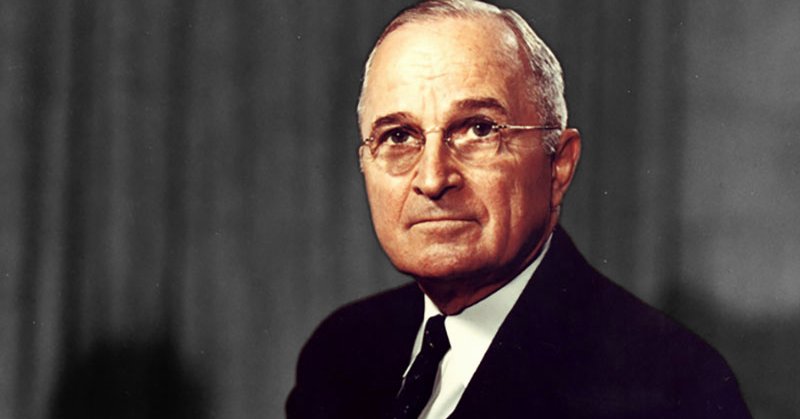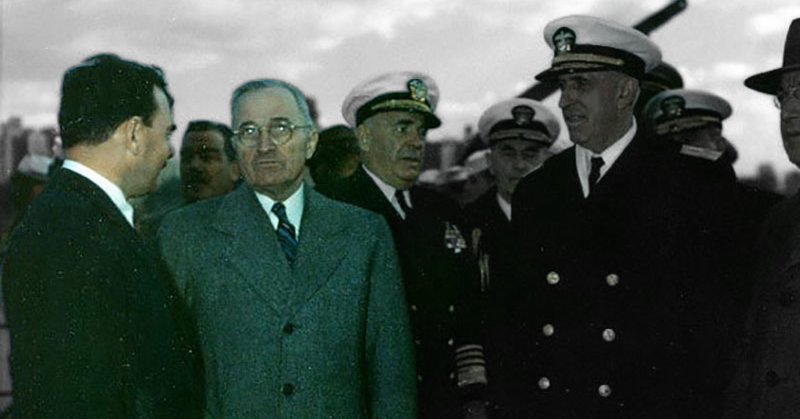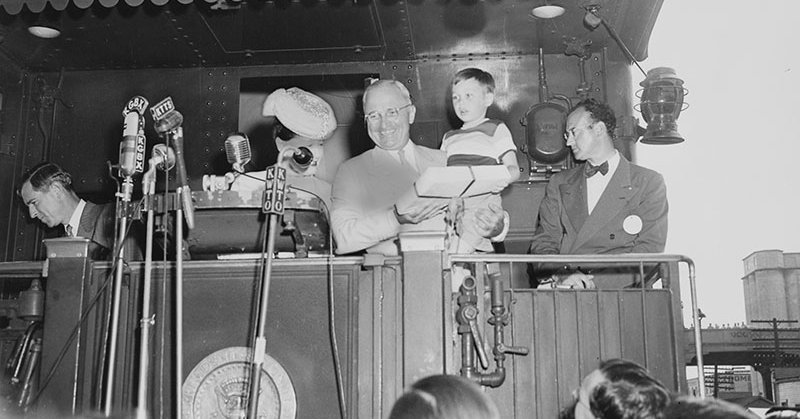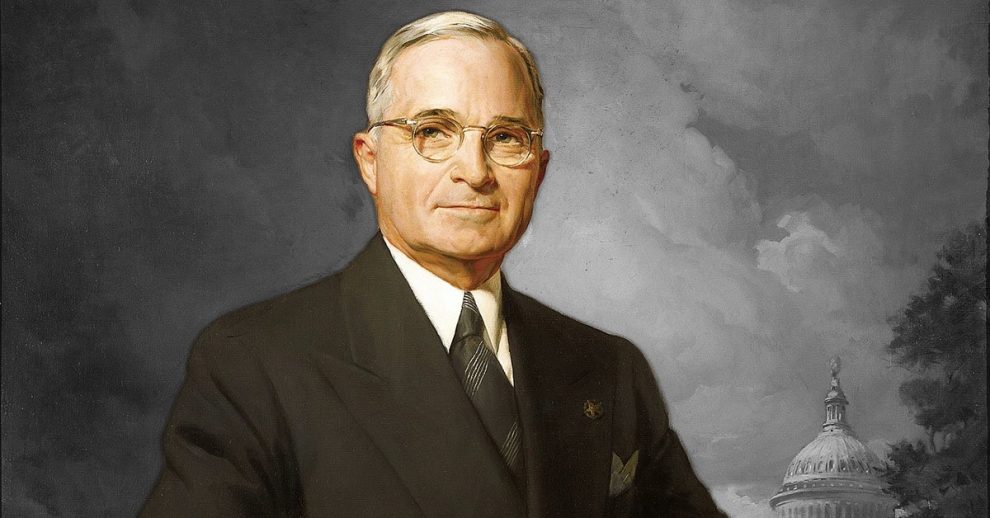Harry S. Truman was born on May 8, 1884, in the small town of Lamar, Missouri, and grew up on farms and in Independence, where he absorbed the plainspoken Midwestern values that marked his career. He married Bess Wallace in 1919, and they had one daughter, Margaret, before his rise from county politics to national office. Truman became the 33rd president of the United States in April 1945, guiding the country through the final months of World War II and the turbulent start of the Cold War until he left office in January 1953. He spent his later years back in Independence and died there on December 26, 1972, after suffering from pneumonia and organ failure, leaving behind a legacy that now looks far more consequential than many critics believed at the time.
Truman’s 5 A.M. Bourbon Start

1. Harry S. Truman began his mornings at 5 a.m. with a shot of Old Grand-Dad bourbon, which he said helped “get the engine running.” He followed it with a hearty breakfast of toast, eggs, bacon, and milk. This routine became a well-known part of his daily life.
2. Harry S. Truman was given only the initial S, not a middle name. The S honors his grandfathers, Anderson Shipp Truman and Solomon Young. Writers have long debated whether to put a period after the S, but Truman’s own letters show he usually included it.
3. As a U.S. senator, Harry S. Truman noticed a vaguely titled project called Expediting Production in wartime funding and asked the Secretary of War about it, only to be told it was classified. He did not learn that this secret program was the Manhattan Project until he became president, when the same Secretary of War finally briefed him on it. When Truman informed Joseph Stalin about the project in July 1945, Stalin showed almost no reaction, because he had already known about it for nearly four years and may have understood it better than Truman did. Troubled by how unprepared he had been about U.S. intelligence, Truman started the practice of giving presidential candidates intelligence briefings in 1952.
4. As a young man in Missouri, Harry Truman wanted to enlist in the Missouri Army National Guard despite his terrible eyesight. To get in, he secretly memorized the eye charts so he could pass the vision test during his physical. In the 1920s, he also joined the Ku Klux Klan for a short time.
5. On April 12, 1945, Vice President Harry S. Truman arrived at the White House, unaware that President Franklin D. Roosevelt had just died at his Warm Springs, Georgia retreat. In her sitting room, a calm Eleanor Roosevelt greeted him and told him that the president was dead. When Truman asked if there was anything he could do for her, she replied that he was the one now in trouble and that they should ask what they could do for him. This is how abruptly Truman had to shoulder Roosevelt’s enormous wartime responsibilities as he became president of a nation still fighting World War II.
6. During an assassination attempt on President Harry S. Truman, White House Police officer Leslie Coffelt stood guard and took the attacker head-on. Shot three times in the abdomen, Coffelt was mortally wounded as he tried to protect the president. Before collapsing, he fired a single round from his revolver and hit Truman’s attempted assassin in the back of the head from 31 feet away, stopping the attack. He later died of his injuries and is remembered as the only U.S. Secret Service officer killed while protecting a president.
7. Long before he became president, Harry Truman met his future wife, Bess, in Sunday School when he was 6 years old and she was 5. He fell in love with her in that childhood classroom and held on to that devotion as he grew up. For the rest of his life, he never loved another woman.
8. During the Truman-era reconstruction of the White House in 1950, President Harry S. Truman approved a souvenir program to help the Commission on the Renovation of the Executive Mansion dispose of surplus materials. The program let members of the public order kits containing old timbers, bricks, facing stones, and paneling removed from the historic building. Demand for these souvenirs exceeded expectations, and receipts from shipping and handling ended up outpacing expenses by 10,000 dollars.
9. In 1950, as McCarthyism surged in the United States, President Harry S. Truman vetoed the McCarran Internal Security Act because he believed it punished opinion rather than crime. He condemned efforts to bar suspected communists from jobs and public life as a way to silence them without directly violating the First Amendment. In his veto message, he wrote, “In a free country, we punish men for the crimes they commit, but never for the opinions they have,” framing McCarthyism as a direct threat to American freedom.
10. In October 1964, former president Herbert Hoover was 90 years old and nearing the end of his life in New York City. Six days before his death on October 20, he sent a telegram to his friend, former president Harry S. Truman, after hearing that Truman had slipped in his bathroom and been injured. That message, wishing Truman a recovery from the accident, became Hoover’s last known written words, while his final spoken words remain unknown.
Filipino Veterans Denied Promised Benefits

11. During World War II, about 250,000 Filipino men answered President Harry Truman’s call to join the U.S. Army and resist the Japanese occupation. They were promised U.S. citizenship and veterans benefits similar to those offered to other Allied soldiers. In 1946, however, Truman signed the Rescission Act, which denied Filipino soldiers those promised benefits. As a result, the Philippines became the only one of 66 Allied nations whose fighters had their compensation rejected.
12. In 1941, Missouri senator Harry Truman took charge of the Senate Special Committee to Investigate the National Defense Program, quickly nicknamed the “Truman Committee,” to police waste and profiteering in U.S. war production. Over the war years, the bipartisan panel exposed enough corruption and inefficiency that it was credited with saving an estimated 10 to 15 billion dollars in military spending, several times the roughly 2 billion dollar cost of the Manhattan Project. The committee’s tough, high-profile investigations turned Truman into a national watchdog figure and became a major reason party leaders chose him to serve as Franklin Roosevelt’s vice president.
13. In 1950, the United Fruit Company spent more than half a million dollars (roughly $6 million in 2022) on lobbying and public relations in the United States to convince lawmakers and the public that Guatemala’s government needed to be overthrown. The company mounted a sustained campaign that painted President Jacobo Arbenz’s land reforms as a dangerous communist move and helped shape Washington’s view of Guatemala as a Cold War problem. As fears about communism in Guatemala grew in the U.S. capital, President Harry Truman in 1952 authorized the CIA to plan a covert coup, a precursor to later operations. Under his successor Dwight Eisenhower, the CIA then helped execute the 1954 Guatemalan coup, turning United Fruit’s lobbying push into a full regime change in Guatemala.
14. In just 29 weeks, Harry Truman went from senator to vice president to president and then authorized the first use of an atomic bomb on Japan. The United States initially put Kyoto on the target list, but Secretary of War Henry Stimson had vacationed there and valued the city for its religious significance, so he urged Truman to spare it. Military planners selected Nagasaki as the replacement target. As a sign of respect to the Japanese, the US Navy will therefore never forward deploy the aircraft carrier USS Harry S. Truman to Japan.
15. During World War II, the United States developed the chemical agent cyanogen chloride for possible use against Japan because it could penetrate standard gas masks and act as a highly toxic blood agent. Truman ultimately rejected plans to use this compound and chose to rely on atomic weapons instead, even though more than 70 Manhattan Project scientists later signed the Szilard Petition to Truman, urging him not to use the bomb on a civilian population in Japan. Cyanogen chloride is now listed under the Chemical Weapons Convention and has never been deployed.
16. Soviet Marshal Georgy Zhukov liked Coca-Cola but did not want to be seen drinking an American product. At his request, relayed through U.S. channels, President Harry Truman helped arrange for a clear, colorless version of Coca-Cola that resembled vodka. The company bottled this “White Coke” in straight clear bottles with a white cap and red star and shipped an initial 50 cases to the Soviet Union so that Zhukov could enjoy it without political embarrassment.
17. In 1957, President Harry S. Truman visited Disneyland and was invited to ride the popular Dumbo attraction. As a Democrat, he did not want to be seen riding in a figure that symbolized the Republican Party. He refused to board the ride.
18. In 1952, Harry Truman considered running for a third presidential term, which he was legally allowed to do under the 22nd Amendment’s grandfather clause. Although he had already served nearly two full terms, the amendment did not apply to him because it was ratified during his presidency. However, when he entered the New Hampshire primary, he suffered a decisive defeat to Senator Estes Kefauver. The loss convinced Truman to step aside, marking the end of his presidential career.
19. In 1952, President Harry S. Truman used the newly rebuilt White House as the setting for the first televised tour of the Executive Mansion. As cameras followed him through its rooms, he explained the building’s history and paused at paintings and furniture to share specific stories about them. He ended the broadcast at the Steinway piano in the East Room, where he sat down and played.
20. In 1945, President Harry S. Truman awarded Melvin E. Biddle the Medal of Honor for his actions during the Battle of the Bulge in World War II. During the presentation, Truman leaned in and whispered, “People don’t believe me when I tell them that I’d rather have one of these than be president.”
Ex-President Rides Train Home

21. On January 20, 1953, when his eight years as president ended, Harry Truman simply boarded a regular train home to Independence, Missouri, chatting with fellow passengers and traveling without any Secret Service protection. In retirement, he refused corporate money because he did not want to cheapen the honor of the office, so for a time his only income was a $112.56 Army pension, leaving him with a net worth well under 1 million dollars and helping spur Congress in 1949 to double the presidential salary to $100,000. As his financial troubles continued, Congress created the presidential pension in 1958, and Herbert Hoover, the only other living ex-president, accepted it too so Truman would not be singled out.
22. In 1946, President Harry Truman learned that a high number of U.S. military draftees were being rejected because of malnutrition. In response, he created the National School Lunch Program to provide regular meals to children through their schools and improve their nutrition before they ever reached draft age.
23. Instead of a marble monument, Harry Truman’s official memorial took shape in 1975 as the Harry S. Truman Scholarship, a federal program honoring his commitment to public service. Each year, it awards up to $30,000 for graduate study to outstanding college juniors who plan careers in government or public service leadership.
24. In 1972, after former president Harry S. Truman died, the federal government closed all federal offices for a national day of mourning. Vietnam draftees who were scheduled to be inducted on that date had their call-up postponed to 1973. When the draft did not restart in 1973, that entire group was never inducted into military service.
25. During the Korean War, William Banning of New Canaan, Connecticut, sent President Harry Truman his dead son’s Purple Heart along with a furious letter that blamed Truman personally for the loss. In the letter, Banning told Truman to keep the medal as a reminder of one of his “historic deeds.” The medal and letter stayed in Truman’s desk for about twenty years and were only discovered there after his death in 1972.














Add Comment